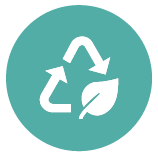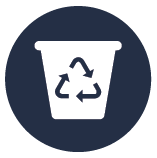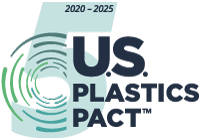Our 2025 Targets
By joining the U.S. Plastics Pact, Activators agree to collectively deliver against these four action items:

TARGET 1
Define a list of plastic packaging that is problematic or unnecessary by 2021 and take measures to eliminate the items on the list by 2025

TARGET 2
100% of plastic packaging will be reusable, recyclable, or compostable by 2025

TARGET 3
Undertake ambitious actions to effectively recycle or compost 50% of plastic packaging by 2025

TARGET 4
Achieve an average of 30% recycled content or responsibly sourced biobased content in plastic packaging by 2025
- Infrastructure, policy, education, access, design, and supply and demand will not be as effective if we do not unite behind a national strategy. Our individual actions alone will not achieve these targets. We must act boldly and be okay with having to quickly adapt or change course as we work together.
- The targets are ambitious. We must aim high with clear, concrete definitions and an understanding of what the real, achievable needs are along the way to 2025. The need is now so the timeframe to accomplish these targets is short and the workload is immense, but we also realize that if we choose to do nothing, the vision of a circular economy across the U.S. will give way to the status quo.
- The U.S. Plastics Pact will lead the way for all materials. This collaborative can serve as a model for a circular economy future in our country where all materials are carefully thought of as resources, and actions are taken to prevent unnecessary waste. We cannot do this without a unified voice of governments, companies, suppliers, re-processors, haulers, MRFs, NGOs, academia, and consumers.
Q: A lot is happening already, so why do we need the U.S. Pact?
A: The U.S. Pact creates a unified national framework for a circular economy for plastics, creating structure, coherence, aligned targets, and associated reporting.
The intent of the U.S. Pact is not to duplicate efforts but to streamline them to ensure existing investments work better and deliver more. The U.S. Pact can help to fill gaps that are currently open and identify gaps in the landscape for pilots. The U.S. Pact can also help to pool funding to support areas that are recognized as needing significant collective attention to help achieve the targets. In addition, the U.S. Pact provides an opportunity to begin engaging companies that are not yet supporting efforts to change the status quo.
Q: What is the benefit to my organization of joining the Pact?
A: Being a part of the Pact is a way to:
- Make progress toward the New Plastics Economy Global Commitment through collaborative action
- Benefit from the knowledge of other organizations
- Advise on national goals, roadmaps and outcomes
- Drive better coordination of existing activities to maximize current and future investments
- Be recognized as a leader in support of national Plastics Pact goals
Q: How can individual companies or organizations work collectively to achieve the targets?
A: Where possible, it is desirable that individual organizational targets are aligned, but not all of the targets are intended to be achieved by individual organizations alone.
In practice this means:
- Incorporating targets into organizational goals where possible;
- Actively collaborating with other stakeholders from across the value chain in relevant U.S. workstreams and activities;
- Actively reviewing internal packaging and product portfolios to identify opportunities to improve recyclability, recycled content, and consumer messaging in accordance with U.S. Pact targets;
- Contributing knowledge and insights to cross-value chain research and analysis;
- Working with suppliers to obtain accurate data for tracking and reporting progress;
- Developing clear accountability internally; providing objectives and training to internal teams to help meet U.S. Pact targets;
- Engaging with citizens through education campaigns, as applicable to organizational reach;
- Investing in changes and technologies to support the achievement of U.S. Pact targets; and,
- Reporting annually in alignment with global reporting through WWF’s ReSource: Plastic Footprint Tracker. Reporting scope will include the volume, weight, polymer type/form/source of the products companies sell in the U.S. This data will contribute to the aggregated reporting for the U.S. Pact.
Q: What does it mean to be an Activator of the U.S. Pact?
A: Being an Activator in the U.S. Pact signals to other companies, the federal government, voters, and consumers that our country cannot wait any longer to take real action on climate change, prevention of marine debris, and waste management. The power of the U.S. Pact is the strength of collective action on the ground in communities and retail and through purposefully designed legislation.
Q: How do I contact the U.S. Pact team to find out more?
Note: Each U.S. Plastics Pact participant must comply with applicable federal and state antitrust laws. This includes not engaging in discussions or sharing of information related to pricing, customers, the ways in which participants compete in the marketplace or any other topic prohibited by applicable antitrust rules and regulations — particularly prices and factors that affect prices, but also subjects such as disaggregated costs, customers, products offered, strategic or business plans and projections. In addition, in accordance with applicable federal and state antitrust laws, we remind you that each participant must make independent, unilateral decisions with respect to U.S. Plastics Pact matters.
